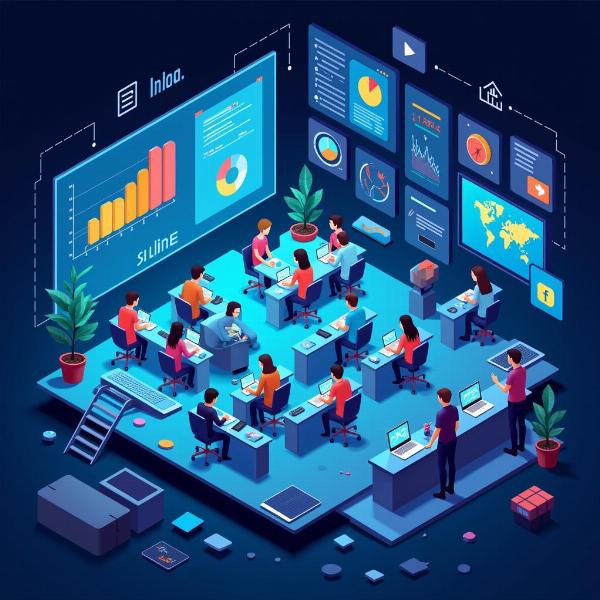EdTech, short for educational technology, is transforming how we learn and teach in India and across the globe. Understanding its meaning in Hindi and its implications is crucial for anyone involved in education, from students and teachers to parents and policymakers. This article explores the “edtech meaning in Hindi,” delving into its various aspects, benefits, and challenges.
What Does EdTech (एडटेक) Mean in Hindi?
EdTech, often translated as “शैक्षिक तकनीकी” (shaikshik takniki) in Hindi, encompasses the use of technology to enhance and improve the learning process. It’s more than just using computers in the classroom; it’s about leveraging digital tools and resources to create engaging, personalized, and accessible learning experiences. This includes everything from online learning platforms and educational apps to virtual reality and artificial intelligence in education.
The rise of EdTech has been particularly significant in India, where it’s bridging geographical gaps and providing access to quality education for millions. It’s empowering students in remote areas, offering personalized learning paths, and creating a more interactive and engaging learning environment.
The Benefits of EdTech in India
EdTech offers a plethora of benefits for the Indian education system:
- Accessibility: EdTech breaks down geographical barriers, making quality education accessible to students in even the most remote corners of India.
- Personalized Learning: EdTech platforms can tailor learning experiences to individual student needs and learning styles, leading to better outcomes.
- Engaging Content: Interactive videos, simulations, and gamified learning make education more engaging and enjoyable for students.
- Cost-Effectiveness: While some EdTech platforms can be expensive, many offer affordable or even free access to educational resources.
- Skill Development: EdTech focuses on developing 21st-century skills like critical thinking, problem-solving, and digital literacy.
“EdTech has the power to revolutionize education in India, empowering learners with the skills and knowledge they need to succeed in the 21st century,” says Dr. Anika Sharma, a leading education expert based in Mumbai.
The Challenges of EdTech in India
Despite its numerous advantages, EdTech also faces some challenges in the Indian context:
- Digital Divide: Access to technology and reliable internet connectivity remains a major hurdle, particularly in rural areas.
- Teacher Training: Educators need adequate training and support to effectively integrate EdTech tools into their teaching practices.
- Quality Control: The rapid growth of the EdTech sector has led to concerns about the quality and credibility of some online learning platforms.
- Affordability: The cost of some EdTech platforms can be prohibitive for many Indian families.
How to Choose the Right EdTech Platform
With so many EdTech platforms available, it can be overwhelming to choose the right one. Consider the following factors:
- Curriculum Alignment: Ensure the platform aligns with the relevant curriculum and learning objectives.
- User-Friendliness: The platform should be easy to navigate and use for both students and teachers.
- Interactive Features: Look for platforms that offer engaging and interactive learning experiences.
- Teacher Support: Choose a platform that provides adequate support and training for teachers.
- Cost and Accessibility: Consider the platform’s pricing and ensure it is accessible on various devices.
 Future of EdTech in India
Future of EdTech in India
“The key to successful EdTech implementation lies in choosing the right platform and integrating it seamlessly into the existing educational framework,” adds Dr. Sharma.
Conclusion
EdTech, or “शैक्षिक तकनीकी” (shaikshik takniki) in Hindi, holds immense potential to transform the Indian education landscape. By addressing the challenges and embracing the opportunities, India can leverage EdTech to create a more equitable, accessible, and engaging learning experience for all.
FAQ
- What is the full form of EdTech? EdTech stands for Educational Technology.
- How is EdTech beneficial for students? EdTech provides personalized learning, engaging content, and increased accessibility to quality education.
- What are the challenges of EdTech in India? Challenges include the digital divide, teacher training, quality control, and affordability.
- How can I choose the right EdTech platform? Consider factors like curriculum alignment, user-friendliness, interactive features, teacher support, and cost.
- What is the future of EdTech in India? EdTech is expected to play an increasingly important role in the future of Indian education, with greater integration of technology and personalized learning.
- Is EdTech only for school students? No, EdTech platforms cater to learners of all ages, from K-12 to higher education and professional development.
- How can EdTech help bridge the education gap in India? EdTech can provide access to quality education for students in remote areas and underserved communities.
Meaning-Hindi.in is your one-stop solution for all your Hindi translation needs. We specialize in various translation services, including business and commercial document translation, certified and legal document translation, technical and user manual translation, website and localization translation, educational and academic document translation, express translation, and specialized translation services. We empower businesses and individuals to communicate effectively across linguistic and cultural barriers. Contact us today for professional and accurate Hindi translation services. Email: [email protected], Phone: +91 11-4502-7584. Get in touch with Meaning-Hindi.in now!